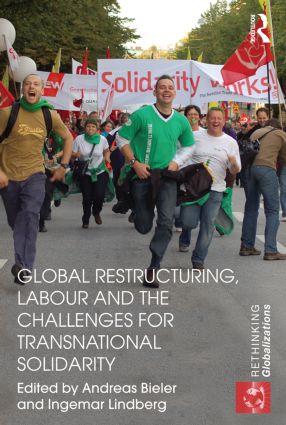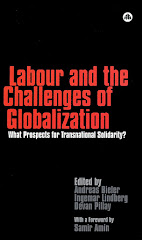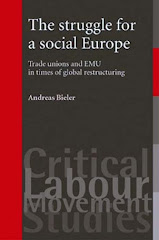Earlier this year, Adam D. Morton and I published our
jointly-authored book Global Capitalism, Global
War, Global Crisis with Cambridge University Press. The book is wide-ranging and moves
from meta-theoretical, to theoretical, to fine-grained empirical analysis of
the agents and structures and thus the relations of force shaping class
struggle in the contemporary world. In this blog post, we argue that the
conceptual focus offered in the book is also relevant for activist struggles in
everyday life.
The relations of force: agents and
structures
In Chapter 2 of Global
Capitalism, Global War, Global Crisis, we argue that enquiry should start
with an investigation of the social relations of production constituting
capitalism in order to comprehend the internal relations between agency and
structure. In capitalism, both social class forces as main collective actors
and structuring conditions, such as competition, profit maximisation and crisis
tendencies, are generated by the organisation of property relations through
wage labour and the private ownership of the means of production. Hence, in
order to assess whether the emergence of class agency is present in specific
moments or conjunctures of struggle, we highlight the need to relate the
potential forms of agency and their processes of becoming to the wider
structuring conditions shaping such action.
It is this relation of strategy to structure, we argue, which is highly relevant for understanding the possibilities of agency against capitalist exploitation and thus important for activists involved in everyday struggles. For example, within the University of Nottingham, based on a broad alliance of campus trade unions, student societies, Students Union officers and the social movement Nottingham Citizens, we have struggled since November 2015 for the University of Nottingham to become a Living Wage employer (see Nottingham – Living Wage City? Living Wage University?). Despite our campaign events, lobbying and political pressure, nothing happened for the first two years. It was only in November 2017, when we organised a public protest outside the Vice Chancellor’s office with local media present that we succeeded in the University committing itself to paying the Living Wage (Nottingham Post, 14 November 2017).
Of course, the action itself on 14
November last year was important in ‘convincing’ the University to agree to
paying the Living Wage. Nevertheless, relating this action to the wider
structuring conditions at the time, allows us to understand the University’s
agreement better. Only a few months earlier, the Labour Party had succeeded in
securing a much better result in the British general elections on 8 June. Part
of Labour’s progressive election Manifesto For the Many Not the Few, widely given credit for the
party’s strong performance, had been a commitment to a minimum wage of £10.
Against the background of widespread support across society for higher hourly
pay, it proved no longer to be possible for management at the University of
Nottingham to decline what it had done─again and again─in meetings with us
over the previous two years. It was the shift in the overall structuring
conditions that ultimately facilitated the success of the Living Wage campaign.
The material structure of ideology
In November 2017, George Monbiot
introduced his new book Out of the Wreckage at a book launch at the University
of Nottingham (also see Out of the Wreckage – George Monbiot
on a new politics in an age of crisis). In his excellent presentation, the main
claim was that in order to overcome current crises, we would need a new
restoration narrative, allowing us to move beyond neoliberalisation and its
disastrous consequences for humanity and our planet as a whole. Nevertheless,
he said little about who should construct such a new narrative, how
such a narrative could become established as the dominant understanding, and why
this narrative and not another, more sinister narrative, for example, would
dominate after the epoch of neoliberalism.
In order to understand these issues,
we argue in Chapter 3 of our book that we need to unpack the material structure
of ideology in order to spotlight questions about the who of power. It
was Antonio Gramsci who stressed the term 'material structure of ideology' to
refer to how a wider class realisation of hegemony had impact across everyday
life, including the social function performed by the built environment in the
production of space, including architecture alongside street layouts (as well
as street names) in addition to libraries, schools, publishing houses,
newspapers and journals, and even the local parish newsletter and the church more
widely. Overall awareness of these aspects of social power would ‘inculcate the
habit of assessing the forms of agency in society with greater caution and
precision’, forewarned Gramsci. Architecture, then, amidst a diverse array of
other social condensations (such as cadastral mapping defining property rights
over land; the drawing of territorial boundaries for administration, social
control and communication routes; or monuments in the production of space)
provides a way of understanding the role played by discourses embedded within
the economy in constituting the ‘material structure of ideology’ (see ‘Monuments Put from Pen to Paper’).
In other words, our historical
materialist approach to the material structure of ideology offers a way of
understanding language as discourse and ideas that is situated within wider
situations of class constitution and struggles over hegemony. Returning back to
the earlier theme of agency and structure, activists in lived spaces of
everyday life seek to bring together marginal and different elements of social
life (struggles against capitalist exploitation and degradation of ecology
and/or over social reproduction) and the homogenising conditions of capitalism
and state power.
In short, these chapters and more within Global Capitalism, Global War, Global Crisis
offer important insights on struggles over everyday life in rattling the lid of
the cauldron of the capitalist state and how to keep on the boil the forces of
difference in constituting a non-capitalist world.
This post was first published on Progress in Political Economy (PPE) on 16 October 2018.














No comments:
Post a Comment
Comments welcome!